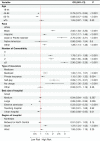Risk factors for perioperative blood transfusion in patients undergoing total laparoscopic hysterectomy
- PMID: 38267957
- PMCID: PMC10809697
- DOI: 10.1186/s12905-024-02908-4
Risk factors for perioperative blood transfusion in patients undergoing total laparoscopic hysterectomy
Abstract
Purpose: The goal is to identify risk factors associated with receiving a blood transfusion during the perioperative period in patients who undergo total laparoscopic hysterectomy (TLH) using a large-scale national database.
Methods: In this retrospective analysis, data from the Nationwide Inpatient Sample (NIS) was utilized to review the medical records of all patients who underwent TLH from 2010 to 2019. The researchers identified patients who had received a blood transfusion during the perioperative period and compared with those who had not. The subsequent factors associated with blood transfusion were examined: hospital characteristics (type of admission and payer, patient demographics (age and race), bed size, teaching status, location, and region of hospital), length of stay (LOS), total charges during hospitalization, in-hospital mortality, comorbidities, and perioperative complications. The data was analyzed using descriptive statistics. The independent risk factors of perioperative blood transfusion after TLH was identified by performing multivariate logistic regression.
Results: A total of 79,933 TLH were captured from the NIS database, among which 3433 (4.40%) patients received a perioperative blood transfusion. TLH patients affected by blood transfusion were 2 days longer hospital stays (P < 0.001), higher overall costs (P < 0.001), the patients who received a transfusion after a long-term hospitalization had a significantly higher rate of mortality (0.5% vs. 0.1%; P < 0.001). Perioperative blood transfusion after TLH was associated with chronic blood loss anemia, deficiency anemia, coagulopathy, congestive heart failure, fluid and electrolyte disorders, renal failure, metastatic cancer, sepsis, weight loss, deep vein thrombosis, gastrointestinal hemorrhage, shock, acute myocardial infarction, and pneumonia, stroke, hemorrhage, pulmonary embolism, and disease of the genitourinary system.
Conclusion: Studying the risk factors of perioperative blood transfusion after TLH is advantageous in order to ensure proper management and optimize outcomes.
Keywords: Blood transfusion; Nationwide inpatient sample; Risk factors; Total laparoscopic hysterectomy.
© 2024. The Author(s).
Conflict of interest statement
The authors declare no competing interests.
Figures





Similar articles
-
Analysis of the incidence and risk factors of blood transfusion in total knee revision: a retrospective nationwide inpatient sample database study.BMC Musculoskelet Disord. 2024 Mar 20;25(1):225. doi: 10.1186/s12891-024-07331-2. BMC Musculoskelet Disord. 2024. PMID: 38509493 Free PMC article.
-
A retrospective analysis of the incidence and risk factors of perioperative urinary tract infections after total hysterectomy.BMC Womens Health. 2024 May 29;24(1):311. doi: 10.1186/s12905-024-03153-5. BMC Womens Health. 2024. PMID: 38811924 Free PMC article.
-
Incidence and risk factor of blood transfusion after abdominal radical hysterectomy for cervical cancer: a 10-year retrospective study of the US nationwide inpatient sample.BMC Cancer. 2024 Nov 26;24(1):1454. doi: 10.1186/s12885-024-13216-3. BMC Cancer. 2024. PMID: 39592990 Free PMC article.
-
Incidence and Risk Factors of In-Hospital Prosthesis-Related Complications Following Total Knee Arthroplasty: A Retrospective Nationwide Inpatient Sample Database Study.Orthop Surg. 2021 Jul;13(5):1579-1586. doi: 10.1111/os.13008. Epub 2021 Jun 9. Orthop Surg. 2021. PMID: 34109750 Free PMC article.
-
Risk factors for perioperative blood transfusion in patients undergoing hysterectomy for benign disease in a teaching institution.Arch Gynecol Obstet. 2022 Jan;305(1):103-107. doi: 10.1007/s00404-021-06223-3. Epub 2021 Sep 10. Arch Gynecol Obstet. 2022. PMID: 34505163
Cited by
-
A retrospective analysis of the incidence and risk factors for amniotic fluid embolism in cesarean deliveries.BMC Pregnancy Childbirth. 2025 Apr 11;25(1):432. doi: 10.1186/s12884-025-07527-x. BMC Pregnancy Childbirth. 2025. PMID: 40217217 Free PMC article.
-
Blood transfusion in percutaneous left atrial appendage occlusion: a nationwide analysis of incidence, predictors, and outcomes.BMC Cardiovasc Disord. 2025 Apr 22;25(1):303. doi: 10.1186/s12872-025-04662-3. BMC Cardiovasc Disord. 2025. PMID: 40263982 Free PMC article.
-
Analysis of the incidence and risk factors of blood transfusion in total knee revision: a retrospective nationwide inpatient sample database study.BMC Musculoskelet Disord. 2024 Mar 20;25(1):225. doi: 10.1186/s12891-024-07331-2. BMC Musculoskelet Disord. 2024. PMID: 38509493 Free PMC article.
-
Assessment of Perioperative Transfusion Risk for Benign Minimally Invasive Hysterectomy Utilizing the ACS-NSQIP.Int Urogynecol J. 2025 May;36(5):1067-1075. doi: 10.1007/s00192-025-06113-1. Epub 2025 Apr 1. Int Urogynecol J. 2025. PMID: 40167601
-
Patient characteristics and adverse effects of allogeneic blood transfusion following lower extremity joint replacement in rheumatoid arthritis: a nationwide inpatient sample database study.BMC Rheumatol. 2025 Aug 13;9(1):101. doi: 10.1186/s41927-025-00554-3. BMC Rheumatol. 2025. PMID: 40804428 Free PMC article.
References
Publication types
MeSH terms
LinkOut - more resources
Full Text Sources
Medical

